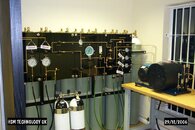Ray, your point is important, critical even and should not be ignored, it also adds to my original point another reason why clay binders should not be used in scuba diving filters. With or without auto drains the problem is the same its just that with auto drains they increase the frequency of the problem.
When a filter is adsorbing water the dry filter “front” travels up through the chemical bed as each bead of chemical does its job of adsorbing (in the case of molecular sieve the water content) as the gas flows around and or through the chemical bed.
Too much gas flowing around the beads is called “channeling” and too much flowing through the bed is called an aggressive “dwell time”
However as the process gas travels along the filter bed length two other reactions occur:
1. The first is that of the wet gas on contact with the fresh dry molecular sieve creates a huge exothermic reaction front and this is a major cause at high pressure air plasma fires within the chemical. Typical temperatures are high enough to easily burn off the anodizing from any aluminium component. However under normal operating conditions the flow of air does cool the reaction front.
2. The use of nitrox or oxygen enriched air mixtures through the filter chemical also increases these exothermic events.
3. The 3rd major problem is at the “spent” end of the filter when the wet liquid water condensate in old or poorly drained filters reacts with the clay in the chemical making in the worst case a solid clay “slug”. Now as the air flow is effectively blocked and air at 207barg (3000psig) is a good pneumatic piston (think air gun) this will either crack the filter cartridge or if a stainless cartridge is used it can “swage” or balloon out the cartridge metal tube and elongate the cap thread holes it is so powerful.
4. Massive pressure drops during draining and auto bleeds turn any moisture within the filter chemical into an expanded ice block, It is this expansion of the ice that caused the filter material to crack up and brake up into a powder slurry, dissimilar binders like clay within the zeolite also are the "fault lines" for this. Remove one componant (the clay) and you reduce your problem.
IMHO if I may make the comment on the specific problem with the Coltri filters it is that there filter diameters are too small for the chemical bead size. Out of interest Ray can you tell me the internal diameter of the Coltri cartridge and its chemical length?
This will get us into a little known event called the “Kepler” effect simply put the relationship between the filter packing and the contact area of the filter wall. Although Kepler was more interested in how many apples you could fit into a barrel and is better known for his work in physics with Keplars 3rd law P^2 = a^3 / mt of motion between planets, his work on the time period squared being directly proportional to the distance cubed.
The one and one only reason why most scuba filters are between 90 to 100mm in diameter is to allow for a chemical cartridge of between 60 to 70mm internal diameter.
It is this relationship between flow, dwell time, pressure drop, and the space between the contact areas of the chemical against the contact area of the filter wall that Johannes Kepler born 1571 died 1630 understood so well and that Coltri doesn't.

LOL Iain Middlebrook.




